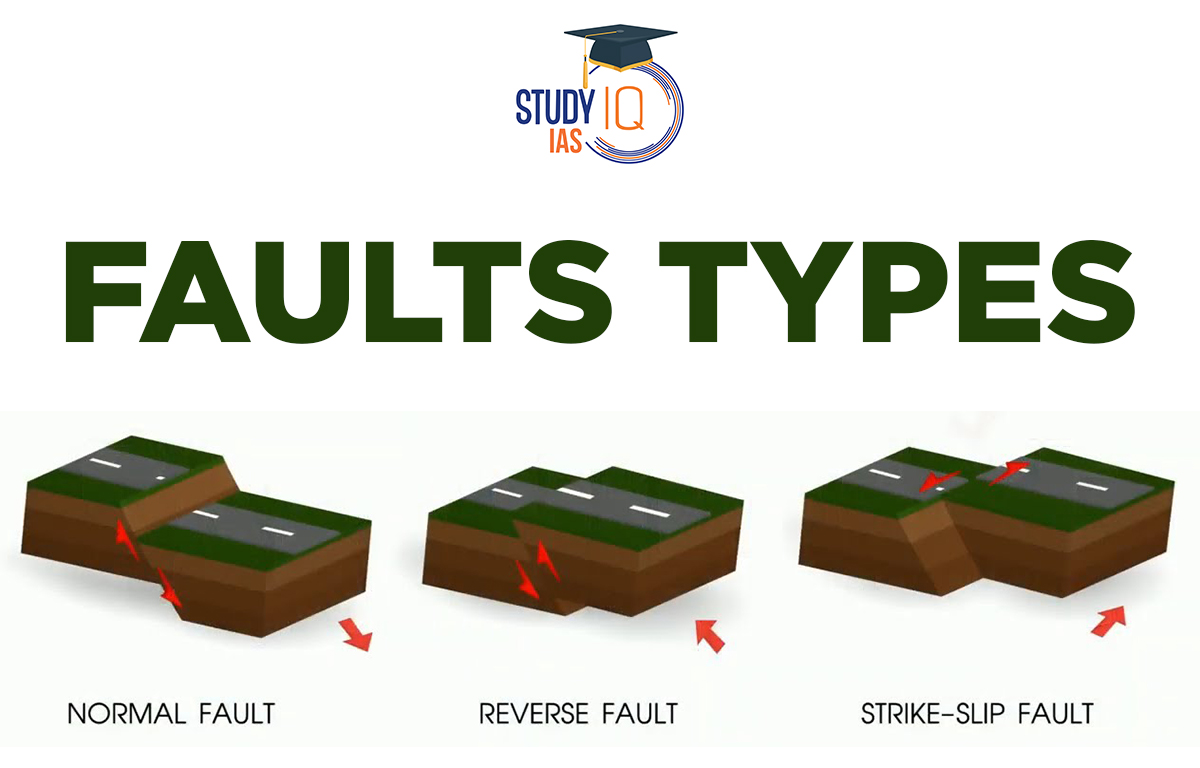Table of Contents
Faults in Geology
A fault is a crack in the Earth’s crust where movement has happened. This movement can be horizontal, vertical, or both. Faults are classified by how the rocks on either side move and are described by their dip angle, strike direction, and motion type. In this article we are going to discuss all types of faults in Geology.
Types of Faults
Based on Movement:
- Normal Fault: The hanging wall moves down compared to the footwall. This happens where the Earth is pulling apart, usually at divergent boundaries.
- Reverse Fault (Thrust Fault): The hanging wall moves up compared to the footwall. This occurs where the Earth is pushing together, often at convergent boundaries.
- Strike-Slip Fault: The rocks on either side slide past each other horizontally. Examples include the San Andreas Fault in California.
Based on Geological Setting:
- Plate Boundary Faults: Located at the edges of tectonic plates, like the San Andreas Fault and the Himalayan Thrust Fault.
- Intraplate Faults: Found within tectonic plates, away from boundaries. An example is the New Madrid Seismic Zone in the U.S.
Based on Displacement:
- High-angle Fault: These faults are steep and can be found in both stretching and squeezing areas.
- Low-angle Fault: These faults are more horizontal and often occur in areas where the Earth is being squeezed.
Based on Fault Geometry:
- Dip-Slip Fault: Movement is mainly vertical. Normal and reverse faults are examples.
- Strike-Slip Fault: Movement is mainly horizontal and can be right-lateral or left-lateral, depending on the direction.
- Oblique-Slip Fault: These faults have both vertical and horizontal movement.
- Listric Fault: This type of fault has a curved surface that gets steeper with depth, often found in areas where the Earth is stretching.
These categories help scientists understand how faults work, which is important for studying earthquakes and the Earth’s history.
Types of Faults Terms Associated
| Fault Plane | It is the plane along which the rock blocks have been displaced. It may be vertical, inclined, or horizontal. |
| Fault Dip | It is the angle between the fault plane and the horizontal plane. |
| Hade | It is the angle between the fault plane and the horizontal plane. |
| Up throw side | It is the block of rock that lies at a relatively greater height than the other. |
| Down throw side | It is the block of rock that lies at a relatively lesser height than the other. |
| Hanging Wall | It is the block of rock resting above the fault plane. |
| Footwall | It is the block lying below the fault plane. |
| Fault Line | It is the intersection of the fault with the earth’s surface. |
| Fault Zone | It consists of various small faults. It is formed when the displacement of the rock is not related to a single fracture but is distributed over a large area. |
Types of Faults Earthquakes & Creeps
Pieces of rock along a fault are always moving but usually so slowly that we do not notice. This slow movement is called a “creep.” Sometimes a larger movement happens releasing a lot of energy suddenly. This is what we call an earthquake. An earthquake occurs when a fault slips quickly. This sudden slip makes the ground shake and sends out energy waves called seismic waves. The point underground where the slip happens is called the “focus,” and the spot on the surface directly above it is called the “epicenter.” Depending on how strong the earthquake is, these waves can cause small shakes or major damage.
Types of Folds
- A symmetrical fold is one with a vertical axial plane.
- An asymmetrical fold is one with an inclined axial plane.
- The limbs of an isoclinal fold are essentially parallel to each other and thus approximately parallel to the axial plane.
- An overturned fold has a highly inclined axial plane with overturned strata on one limb.
- The axial plane of a recumbent fold is essentially horizontal.
Causes of Faulting
Tectonic Forces:
- Compression: Plates push together, causing reverse faults.
- Extension: Plates pull apart, creating normal faults.
- Shear Stress: Plates slide past each other, forming strike-slip faults.
Volcanic Activity: Movement of magma can create fractures and faults.
Fault Reactivation: Old faults can become active again due to new stress.
Localized Stress: Weight from above rocks or existing weaknesses can cause faults.
Human Activities: Mining, reservoir filling, fracking, and nuclear tests can trigger faults.
Isostatic Rebound: After ice melts, the crust can lift, creating new faults.
Continental Rifting: When continents start to split, normal faults can form.
Impact Events: Meteorite impacts can cause fractures in the crust.
Salt Tectonics: Movement of salt in sedimentary basins can create faults.
Effects of Faulting
Earthquakes: Faults can cause ground shaking and damage when rocks move.
Fault Scarps: Steep slopes created by fault movement, visible on the surface.
Landscape Changes: Faults can create mountains, valleys, and rift valleys.
Fault-Related Landforms: Features like horsts (high areas) and grabens (low areas) form near faults.
Mineral Deposits: Faults can transport mineral-rich fluids, leading to valuable deposits.
Groundwater Movement: Faults can affect how groundwater flows and creates aquifers.
Volcanism: Faults can help magma reach the surface and contribute to eruptions.
Seismic Hazards: Faults in cities can damage buildings and infrastructure during earthquakes.
Aftershocks: Smaller earthquakes can occur after a larger one, causing further disruption.
Fault Zones: Areas with multiple fractures can provide insights into fault history.
Geological History: Studying faults helps understand past tectonic events and landscape changes.
Natural Resource Exploration: Faults influence where resources like oil and gas are found.
Environmental Impact: Faulting can change drainage patterns and affect ecosystems.
Tectonic Plate Movements: Faulting is part of how Earth’s plates move and interact.
Overall, faulting affects many aspects of the Earth and human life, making its study important for understanding geological processes and reducing earthquake risks.
Types of Fault UPSC
A fault is a crack in the Earth’s lithosphere formed by the collision of two pieces of rock. Because rock fragments can move at a fault, earthquakes can occur if the movement pushes those fragments into or past one another. Faults can be found all over the world and can range in length from a few millimetres to thousands of kilometres.
However, many faults are inactive, which means that no earthquakes occur on them. Active faults are those where earthquakes happen. The word fault is derived from the Old French term falte, which means an opening or gap.
A solid understanding of this subject is required to help individuals pass competitive exams. On that note, we have covered this topic exclusively for students preparing for the UPSC and IAS exams.


 Story of Meera Bai and Her Devotion For ...
Story of Meera Bai and Her Devotion For ...
 Desert Climate, Distribution, Climatic C...
Desert Climate, Distribution, Climatic C...
 Deserts of India Map, Features of Thar D...
Deserts of India Map, Features of Thar D...





















